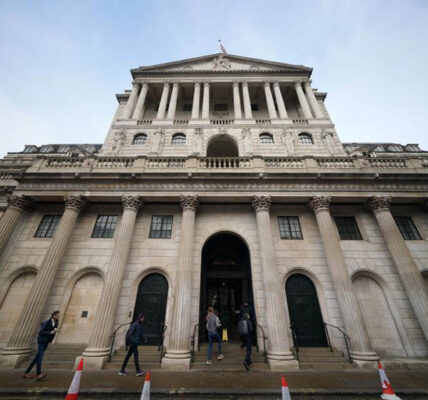Eurozone inflation rate drop to 1.8% in September brings inflation below the European Central Bank’s 2% target, raising hopes for faster interest rate cuts and potential economic recovery.

© Copyright 2024 The Associated Press. All rights reserved
Eurozone Inflation Rate Drop Below 2% Sparks Hope for Faster Rate Cuts
The Eurozone inflation rate drop to 1.8% in September has brought relief to consumers and opened the door to potential interest rate cuts by the European Central Bank (ECB). This is the first time in over three years that inflation in the 20 countries using the euro has fallen below the ECB’s 2% target. The decrease comes as energy prices decline, bringing relief after a period of soaring inflation that, at its peak, reached double digits. This change could lead to quicker cuts in interest rates, providing much-needed support to the region’s slow economic growth.
A Significant Eurozone Inflation Rate Drop in September
The Eurozone inflation rate drop from 2.2% in August to 1.8% in September marks a critical moment for the ECB. This decline in inflation is largely driven by falling energy prices, which dropped by 6%, according to Eurostat, the European Union’s statistics agency. For the first time since June 2021, inflation is below the ECB’s target, which stood at 1.9% back then. The September inflation rate has renewed discussions among economists about the possibility of faster interest rate cuts, with some now considering a potential reduction as early as the ECB’s next meeting on October 17.
Just a few weeks ago, most experts believed the central bank would wait until December before making another move. However, the combination of the Eurozone inflation rate drop and a lackluster economic growth outlook could push the ECB to act sooner.
What Is Driving the Eurozone Inflation Rate Drop?
The Eurozone inflation rate drop is primarily due to the significant decline in energy prices. Over the past year, energy costs have been a major driver of inflation across Europe, particularly following Russia’s invasion of Ukraine. The conflict led to severe disruptions in energy supply, especially with Russia cutting off natural gas pipelines to Europe. This caused energy prices to spike, contributing to the inflationary pressures faced by consumers.
Now, energy prices have eased, offering relief to households and businesses across Europe. With energy prices falling, inflationary pressures have decreased, leading to the Eurozone inflation rate drop we see today.
Additionally, the growth outlook in many parts of Europe remains weak. Germany, the eurozone’s largest economy, recorded inflation at 1.8%, while Italy, the third-largest, reported inflation as low as 0.8%. In both cases, the Eurozone inflation rate drop reflects broader economic challenges, including low consumer spending and stagnant growth.
Impact of the Eurozone Inflation Rate Drop on ECB Policies
The Eurozone inflation rate drop below 2% is significant because it brings inflation in line with the ECB’s target. Central banks like the ECB use interest rate hikes to control inflation by making borrowing more expensive, which reduces spending and, in turn, lowers inflation. However, high interest rates also slow down economic activity, which can harm growth.
Over the past few years, the ECB, like other central banks such as the U.S. Federal Reserve, raised interest rates rapidly to fight inflation. As inflation has now fallen below the target, the focus is shifting toward lowering interest rates to stimulate growth. With the Eurozone inflation rate drop to 1.8%, the ECB faces a delicate balancing act: they need to ensure inflation remains under control while also encouraging economic recovery.
Economists are closely watching the ECB’s next moves. While some believe that the central bank should wait to ensure inflation doesn’t rise again, others argue that faster rate cuts could help the struggling eurozone economy. The decision will likely depend on the ECB’s assessment of incoming economic data in the coming weeks.
Could Inflation Rise Again Despite the Eurozone Inflation Rate Drop?
Despite the Eurozone inflation rate drop to 1.8%, there are still some concerns that inflation could rise again before the end of the year. Economists have noted that while energy prices have fallen, other components of inflation, such as service prices, remain high. This could lead to a slight uptick in inflation in the coming months, potentially complicating the ECB’s decision-making process.
ECB President Christine Lagarde has made it clear that the bank is not committing to a set schedule for future rate cuts. Instead, the ECB will continue to monitor the economic situation closely and make decisions based on the latest data. The Eurozone inflation rate drop is undoubtedly a positive sign, but the central bank remains cautious about declaring victory over inflation just yet.
Weak Economic Growth Complicates the Picture
The Eurozone inflation rate drop comes against a backdrop of weak economic growth. The eurozone economy grew by just 0.3% in the second quarter of this year, reflecting ongoing challenges such as low consumer spending and the uncertainty created by global conflicts. Wars in the Middle East and Ukraine have weighed heavily on consumer confidence, as have reports of layoffs and potential job cuts at major European companies.
Germany, in particular, is facing economic difficulties. The Eurozone inflation rate drop to 1.8% in Germany is partially the result of weak economic growth in the country. Italy, too, has seen inflation fall to 0.8%, a sign that its economy is also struggling. With growth prospects looking dim, the ECB will need to consider how best to support the economy while keeping inflation in check.
What’s Next for the ECB?
The Eurozone inflation rate drop has shifted the focus to the ECB’s upcoming meeting on October 17. Many economists now believe that the central bank could announce a rate cut sooner than expected, given the lower inflation figures. Previously, most experts predicted that the ECB would wait until December to lower rates again. However, the weaker-than-expected economic growth, combined with the Eurozone inflation rate drop, has changed the outlook.
If the ECB decides to cut rates, it could provide much-needed relief for businesses and consumers by lowering borrowing costs and stimulating spending. However, the central bank will need to tread carefully. Inflation could still rise again, particularly if energy prices fluctuate or if other inflationary pressures, such as in services, persist.
In the coming months, the ECB will likely continue to evaluate the economic data closely, balancing the need for inflation control with the need to support growth. The Eurozone inflation rate drop is a positive development, but it is just one part of the broader economic picture.
Conclusion
The Eurozone inflation rate drop to 1.8% in September is a welcome sign for both consumers and the ECB. It signals a potential turning point in the fight against inflation, with energy prices providing much-needed relief. However, weak economic growth and ongoing global uncertainties mean that the ECB faces tough decisions ahead. As the central bank navigates these challenges, the next few months will be critical in shaping the eurozone’s economic recovery and the future direction of interest rates.
Related:
Santander Green Mortgage Discounts: 5 Incredible Savings Opportunities!




